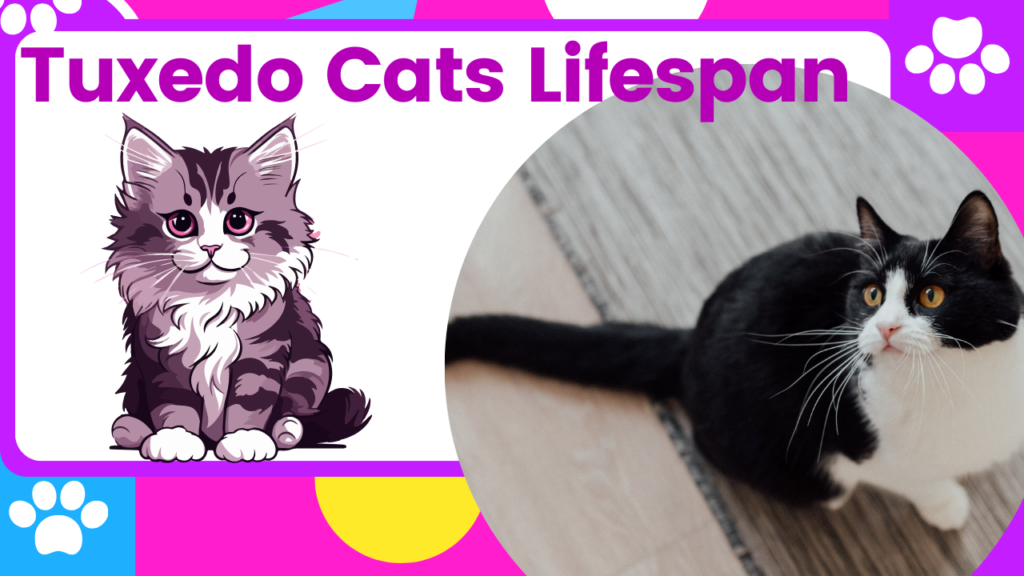Bicolor cats, particularly tuxedo cats with their iconic black-and-white “formal wear” patterns, are adored worldwide for their charm, intelligence, and distinct appearance. This guide dives deeply into the lifespan, health, and lifestyle factors affecting bicolor cats, with a special focus on tuxedo cats.
What Affects the Lifespan of Bicolor (Tuxedo) Cats?
1. Genetics and Breed Influence
The lifespan of bicolor cats, including tuxedo cats, is greatly affected by their breed. While tuxedo patterns appear in many breeds, each breed has specific health traits that can influence lifespan. For instance:
- Domestic Shorthairs often live between 12–15 years if kept indoors.
- Maine Coons, known for their larger size, may face unique health challenges but can also reach 12–15 years with proper care.
- Turkish Angoras and British Shorthairs commonly exhibit tuxedo coloring and may live 15+ years if maintained in optimal health.
2. Indoor vs. Outdoor Living
Whether a tuxedo cat is kept indoors or outdoors greatly impacts their lifespan. Indoor cats generally live significantly longer, often exceeding 15 years, while outdoor cats face increased risks of accidents, disease, and predation, averaging around 2–5 years.
3. Diet and Nutrition
Providing high-quality nutrition promotes the health and extends the lifespan of tuxedo cats.. A diet rich in protein, with controlled portions to prevent obesity, is crucial for bicolor cats. Avoiding excessive fillers and processed foods can reduce risks of diabetes and heart disease, which can impact longevity.
4. Regular Veterinary Care
Routine check-ups are essential for spotting early signs of health issues, especially in aging cats. Regular vaccinations, dental care, and parasite prevention further enhance the quality and length of life for tuxedo cats.
Typical Lifespan of Bicolor Cats by Breed
| Breed | Average Lifespan (Years) |
|---|---|
| Domestic Shorthair | 12–15 |
| Maine Coon | 10–15 |
| British Shorthair | 14–20 |
| American Shorthair | 12–16 |
| Turkish Angora | 15–18 |
Unique Traits of Tuxedo Cats
Tuxedo cats are more than just visually striking; they possess personality traits and unique behaviors that set them apart.
1. Intelligence and Trainability
Tuxedo cats are often noted for their intelligence and ease of training. Many tuxedo cat owners report that these cats are more responsive to commands and learn tricks faster than their counterparts. While no scientific study fully substantiates this, anecdotal evidence suggests tuxedo cats exhibit curiosity and problem-solving skills that make them delightful companions.
2. Affectionate and Sociable Nature
Tuxedo cats are often perceived as highly social and affectionate. They tend to enjoy human interaction, making them suitable for families or individuals seeking a close bond with their pet. While every cat has a unique personality, tuxedo cats are known for their warmth and loyalty.
3. Playful and Energetic
Tuxedo cats are famous for their lively and playful nature. They often enjoy interactive play with toys and climbing structures, which also helps keep them physically active and mentally engaged. Regular play can contribute to a healthy lifestyle, minimizing obesity and related health risks.
Health Factors Influencing Tuxedo Cat Lifespan

Common Health Issues
Tuxedo cats, like all cats, may encounter breed-specific health challenges. Here are a few potential issues to monitor:
- Heart Disease: Certain breeds with tuxedo patterns, like Maine Coons, are prone to hypertrophic cardiomyopathy.Routine screenings can aid in early detection and management of these conditions.
- Dental Disease: Tuxedo cats may be susceptible to plaque and tartar buildup, leading to gum disease if untreated.
- Obesity: Due to their playful nature, tuxedo cats are usually quite active, but maintaining a balanced diet is essential to prevent weight-related issues.
Quick Development in Kittens
Tuxedo kittens tend to develop quickly. For example, tuxedo kittens may open their eyes faster than other cats and achieve their full height by six months. This accelerated development requires attentive care during the early months to support growth and immune health.
Ideal Care Routine for Tuxedo Cats
Providing optimal care is essential for ensuring a long, healthy life for tuxedo cats. Here’s an ideal care regimen:
1. Nutrition and Weight Management
Quality nutrition tailored to the cat’s breed and age is critical. Consider the following dietary guidelines:
- Protein-Rich Diet: Cats thrive on protein, which should make up a substantial portion of their diet.
- Portion Control: Avoid overfeeding, as obesity can lead to various health complications.
- Hydration: Provide fresh water daily and consider wet cat food to increase water intake.
2. Regular Veterinary Visits
Biannual vet visits can help monitor health, update vaccinations, and screen for common ailments. As tuxedo cats age, more frequent check-ups are recommended.
3. Mental Stimulation and Physical Activity
Tuxedo cats’ intelligence makes them excellent candidates for interactive toys and puzzle feeders. Keeping them engaged with toys, cat trees, and interactive games promotes mental and physical well-being.
4. Grooming Routine
Though many tuxedo cats are self-groomers, brushing them once a week can help reduce shedding and hairballs. For long-haired tuxedo cats, daily grooming may be required.
Bicolor Cat Genetics: Understanding Tuxedo Coat Patterns
Tuxedo cats display the piebald or bicolor coat pattern, where the gene controlling melanin distribution doesn’t fully cover the body. This genetic quirk creates the unique, tuxedo-like black and white pattern.
mermaidCopy codegraph LR
A[Melanocyte Distribution] --> B[Genetic Inheritance]
B --> C[Melanin Inhibition on Certain Areas]
C --> D[Tuxedo Pattern Formation]
In this diagram, melanocyte distribution (A) affects the gene responsible for melanin, leading to specific areas where melanin is inhibited, forming the tuxedo pattern.
Conclusion: Ensuring a Long, Healthy Life for Tuxedo Cats
Bicolor cats, particularly tuxedo cats, bring a unique blend of elegance and personality to their owners. Understanding their lifespan, health considerations, and providing optimal care can help these cats lead long, fulfilling lives. With attention to diet, regular veterinary care, and a stimulating environment, tuxedo cats can thrive and remain beloved companions for many years.
#: READ ANOTHER POSTS
1 : Why Do Bengal Cats Have Spots
2 : How to Measure Your Cat’s Heart Rate While Purring: A Comprehensive Guide


